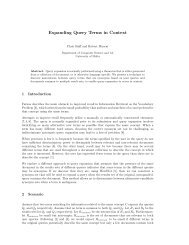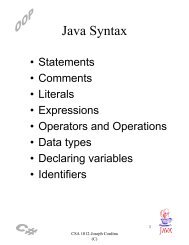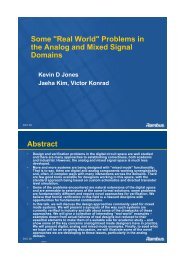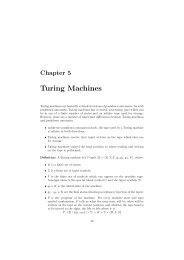Proceedings of CSAW'04 - FTP Directory Listing - University of Malta
Proceedings of CSAW'04 - FTP Directory Listing - University of Malta
Proceedings of CSAW'04 - FTP Directory Listing - University of Malta
You also want an ePaper? Increase the reach of your titles
YUMPU automatically turns print PDFs into web optimized ePapers that Google loves.
Simulo Tempestas: A Simulation Tool for Hydrological Modelling 11<br />
Simulation Tool The simulation tool is responsible for running the actual simulation. Its primary<br />
objectives are:<br />
– to allow the user load project files from the world-editor tools,<br />
– to allow the configuration <strong>of</strong> simulation run-time parameters,<br />
– to be as explicit as possible by having a mixture <strong>of</strong> 2D and 3D elements,<br />
– to produce results relevant to flood analysis,<br />
– to allow the user to save the outcome <strong>of</strong> a simulation for future use.<br />
2 Design<br />
Simulation tools are quite useless if they are not versatile in their configuration. However, versatility<br />
might also mean the introduction <strong>of</strong> additional complexity to the system which results in an<br />
unnecessary cognitive overload on the user. It is for this reason that Simulo Tempestas has been<br />
subdivided into three different parts, each part designated as an application <strong>of</strong> its own. With three<br />
distinct applications, each <strong>of</strong> them having their own specific role in the system, the user will be<br />
able to grasp their use faster than having one big application carrying out a multitude <strong>of</strong> different<br />
functionalities. The following is how the system is divided:<br />
1. Terrain Modifier: A tool that allows the user to modify the terrain to be able to test new<br />
situations; e.g building dams, creating deeper basins, creating new canals, etc<br />
2. Simulation Configuration Tool: This tool allows the user to create the climatic environment<br />
and terrain settings to be used in the simulation.<br />
3. Simulation Tool: The tool responsible for carrying out the simulation itself depending on the<br />
settings given to it using the previously mentioned tools.<br />
During the research phase it was seen how the problem domain has been tackled by others during<br />
the past years. The different techniques related to hydrological modelling with their pros and cons<br />
were analysed. It is rather useless implementing something already done before, therefore important<br />
changes are made by using the best <strong>of</strong> the these different models to come up with a fresh solution<br />
to the problem.<br />
2.1 Terrain<br />
The terrain is a very crucial aspect in hydrological modelling as without it there is nothing to<br />
model. Hence, in a computer simulation, the terrain itself as well as the quality <strong>of</strong> the terrain<br />
data is quite important. Something <strong>of</strong> real importance is that the terrain model is represented<br />
in the most efficient way possible so that any operations can be performed quickly. This is a big<br />
prerequisite especially in real-time simulations. The size <strong>of</strong> the terrain and the underlying data<br />
structure with which it is represented directly affect the efficiency <strong>of</strong> the algorithms manipulating<br />
the terrain data.<br />
Digital Elevation Model The system makes use <strong>of</strong> 50-metre Digital Elevation Model which<br />
is nothing more than a 2-dimensional grid for which elevation data exists at the intersections <strong>of</strong><br />
the grid rows and columns. The spacing between the points on a DEM grid (i.e. the row and<br />
column, height and width respectively) directly affects the level <strong>of</strong> detail <strong>of</strong> a DEM. In the case













